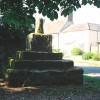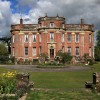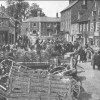St. Michael the Archangel is a church steeped in history, yet one that seems perilously close to being lost to the sea. Although it was suspected the Saxons built a church where St. Michael’s now stands, until 1994-5 there was no proof of this. During that time repairs to the tower uncovered a window dating from about 980 in a wall of the belfry chamber. This find made it probable that the lower two-thirds of the tower is Saxon. When the Normans rebuilt the remainder of the church about 1120, they largely retained and updated the Saxon stonework.
This and other later developments and alterations made any description of the first church or chapel on the site a matter of conjecture. Certainly the present porch supersedes the foundation of the Saxon nave. The Normans however made their church plan cruciform, and there is some evidence that the nave had an aisle on the north side and an aisle or chantry on the south side. The tower was probably situated centrally with transepts and an apse at the east end. The present porch is all that remains of the Norman nave. It once extended ten feet further west than today, but the extension was demolished when the road outside was widened in 1824.
A room known as “The Old Vestry” formerly occupied the floor above the porch, but was removed during a phase of restoration in 1933. At this time the contractors took the opportunity to reveal as much Norman masonry as possible. They rebuilt the west front, intending to add new north and south aisles to the sides of the porch so that the original 12th century arches could be shown off to best advantage.
When viewed from outside, this end of the church has an unfinished appearance. The work was apparently left incomplete when funding dried up, and because of inflation it is considered unlikely that the work will ever be completed. The various structural alterations to the church over the centuries are also clearly in evidence when the building is viewed from the east (seaward) end of the churchyard. For example, the apex of the nave/aisle roof stands about one metre above the apex of the chancel roof, the elevation being faced with dark shingles or bricks seen no-where else in the church’s fabric or structure.
From the porch the visitor enters the Baptistry under the tower. Standing in the centre must be one of the most sumptuous and elaborate fonts in the county and beyond. The font is the parish’s memorial to the Revd. Frederick Parry-Hodges, who was vicar of Lyme during most of the Victorian period. Beyond the Baptistry the nave is entered through the Norman chancel arch, while the arches to the north and south, though walled up, are 13th century and infused into the earlier Saxon tower. This re-ordering is further complicated by the upper levels of the tower, which were added in the early 16th century, raising its height to the present 58 feet.
The present nave, though roughly contemporary with the elevation of the tower, is in stark contrast to the austerity of the porch. It is well proportioned and spacious, and was pitched at a slight upward gradient towards the high altar. The nave has been restored several times, the most recent being in 1885, when the upward slope was replaced by broad steps which originally spanned the whole church. But the rest of the re-ordering of 1885 was concerned with rendering the interior suitable for the worship of the time. The exterior too, has needed and received frequent restoration work. The nave has six bays, the two easternmost forming the chancel. There are some fine carvings around the pillars, and there is a fine set of roof bosses. The ceiling of the chancel was embellished with a painting of the Raising of the Cross in about 1850.
There are no original stained glass windows remaining in St. Michael’s. The window on the left side of the porch is a memorial to Thomas Coram, a wealthy Lyme captain and merchant seaman who ended his days in penury. The second window along the north side of the nave portrays Sir Galahad’s vision of the Holy Grail. The east window was once nearly twice its present length, but was reduced during the restoration of 1885. But the first window along the north side is particularly interesting, for although she is not portrayed within it, the window is in memory of Mary Anning, Lyme’s pioneering woman fossil collector and dealer of the early 19th century.
The church has two examples of Jacobean wood carving in the west gallery and the pulpit. The chancel screen commemorates the Revd. George Barlow. Among the memorial brasses can be seen the bell from HMS Lyme Regis (1942-1948) which in 1944 took part in the Second Front D-Day landings in Normandy. Most church plate is modern, and the organ was acquired from St. Mary Major church, Exeter, in 1939. Further down the nave on the north side can be seen the most remarkable and enigmatic possession of the church. This is the highly controversial Lyme Tapestry, widely supposed to be the work of Flemish weavers around 1490.
Lyme Church is remarkable for its ring of bells, which today actually number twelve. In their structural alterations to the tower the Normans specifically intended it should house bells, though nothing is known of those which preceded the first new ring of six bells hung in 1770. The fourth of these bells was re-cast in 1843 with the inscription “O Sea Spare Me.” The ring was re-hung in a new oak frame in 1911, when two more were added. Then in 1953 all eight were re-cast again and dedicated to the Bishop of Sherborne. A further four bells (two large and two small) were added in 1988.
The main bells made local news when they had to be lowered into the tower by a Sea King helicopter hired from RNAS Culdrose. The two small bells were mounted in a frame designed and constructed by the ringers themselves. All the bells are noted for the quality of their tone, and campanologists from all over the country come to Lyme to ring them. In 1995 a record was set when the longest unaided and unbroken peal of Surprise Royal was rung at St.Michael’s.
The Church registers date from 1538 and with the exception of a single entry in 1649, there is a gap from 1572 to 1653. The pages also contain information about certain significant dates for events. For example there is one entry stating. “1759, 31st May – the sea flowed in three times in an hour at Lyme.”
The churchyard, while not overcrowded with burials, features headstones or table-tombs almost entirely worked from local Lias limestone. As in many Dorset churchyards inscriptions have become largely obscured by lichen. For different reasons two of these monuments in particular stand out from all the rest. One is the large limestone slab marking the last resting-place of Mary Anning, and which lies almost opposite her memorial window in the church. This grave, however, is not exclusively hers, for she shares it with her brother Joseph and some infant children of the family.
The other memorial is prominent by being pristine, un-weatherable red granite monument within a low enclosure in the south-east quarter of the churchyard. This is the grave of the aforementioned Revd. Frederick Parry-Hodges, incumbent at St. Michael’s from 1833 to 1880. It can be assumed therefore, that it was this minister who would have presided over the burials of Mary Anning and her family.



